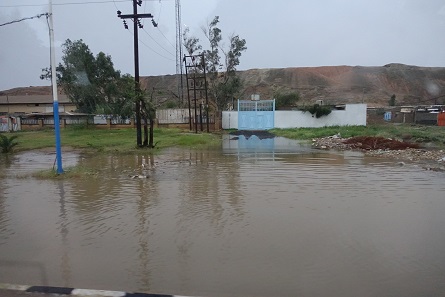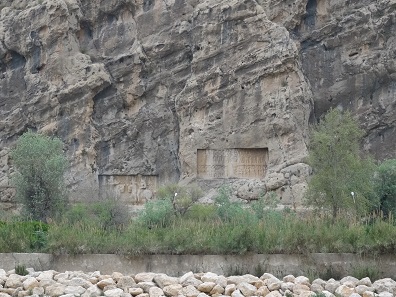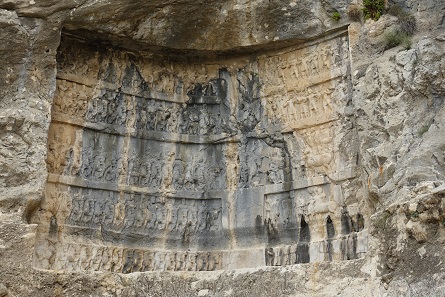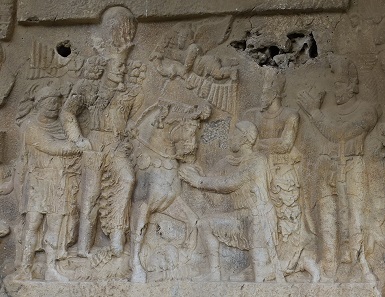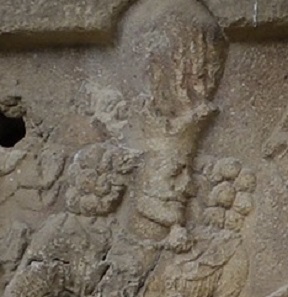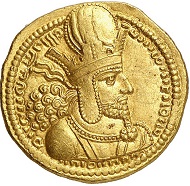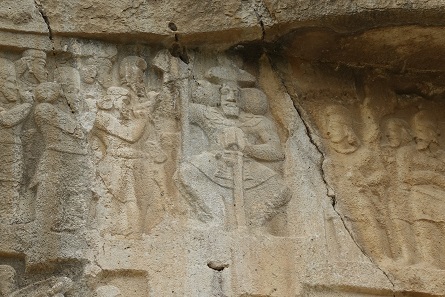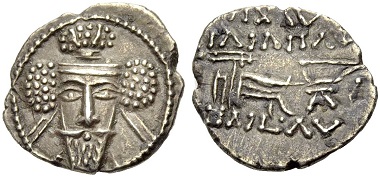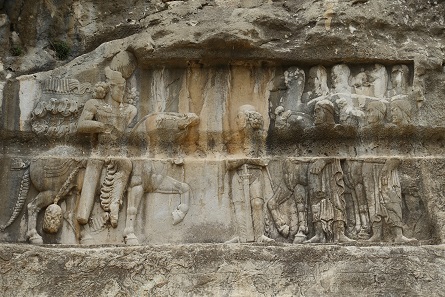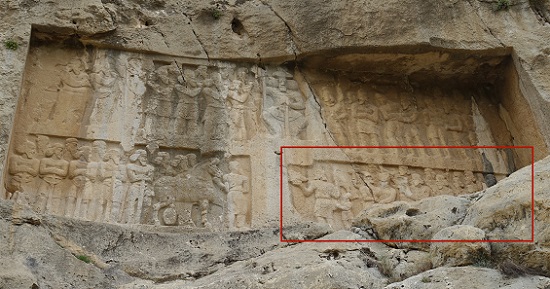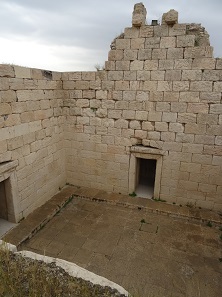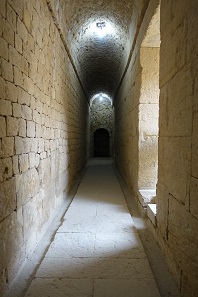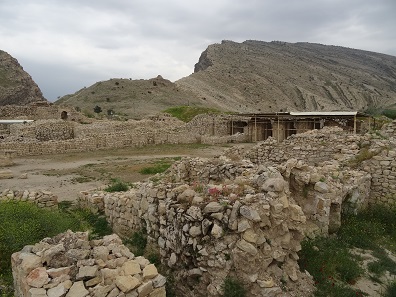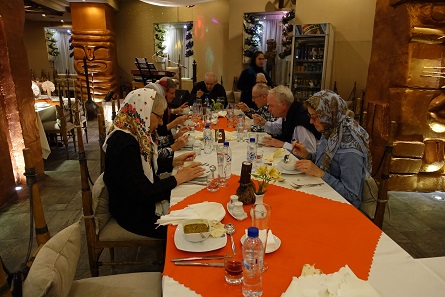by Ursula Kampmann
translated by Teresa Teklic
January 19, 2016 – Our historical understanding is dominated by Rome. Which is largely due to the difficulties the average historian has with Latin and Greek, making him reluctant to learn Middle Persian on top of that. Not to mention the fact that only few fragments of Sassanid literature have survived.
Still, it is impressive to realize all of a sudden that in the East there was a global power equal to Rome. In this episode of our Iran diary we visit the former empire’s capital.
High water in the morning. Photo: KW.
Tuesday, 15 March 2016
Wake-up all at 4.30 am. Breakfast at 5.30. You probably wouldn’t call anyone in that breakfast room awake. Still, we were sort of functional, heaping food on our plates, getting to the bus in time and taking off at 6.00 sharp so we would not only fit in the long bus drive but also the heavy schedule.
On the bus I wasn’t sure whether I was still dreaming or whether the streets were really flooded. My very vivid dream from last night had featured thunder and lightning, and in the morning the dream had become infused with reality and vice versa. The streets had disappeared and there were only small rivulets, some deeper than others. The nightly rain had drowned everything. But of course that didn’t stop us …
A look at the rock relief of Bishapur. Photo: KW.
After all the Sassanids were on the agenda for today. Or rather the city Bishapur. Now don’t say you’ve never heard of Bishapur before! Well, ok, you wouldn’t be the only one. Even during the course of my studies in ancient history Bishapur had only been mentioned in passing, if at all. At least that’s what I assume because it must have happened during a moment of mental absence on my part. And that in spite of the fact that Bishapur was really important. After all we are talking about the new capital that Shapur founded after his victory over the Romans. Bishapur – or Bay-Shapur, like a Sassanid might have pronounced it – simply means Lord Shapur, you must know. And that is no different from your Roman Traianopolis and Hadrianapolis and what have you.
Relief of Shapur I, showing his victory over Gordian III, Valerian, and Philip the Arab. It is said to be modeled on the bands of the Trajan’s Column. Photo: KW.
If you travelled to Bishapur back in the days, you travelled on a road that already made it clear to you that the Sassanids, not the Romans, ruled the world. You had to pass by six giganto rock reliefs before entering the city. When our bus arrived in this solitude it was long past our usual lunch hour and we were starving.
Shapur I surrounded by Roman emperors. Photo: KW.
What we saw next made us loose our appetite for the moment. Shapur I stages his victory over the Romans. He rides on horseback, stepping on a dead body.
Gordian III lying under the hooves of Shapur’s I stallion. Photo: KW.
The body under the hooves is no one other than Gordian III, who died on his campaign against the Sassanids as we all know. They had conquered Hatra in 240/1, which is when the grey eminence behind Gordian’s throne, Praetorian Prefect Timosethius, father-in-law to Gordian III, no more than 19 years old at the time of his death, set the military machinery in motion. In the fall of 242 the army reached Antiochia, attained first successes, and then, unfortunately, the father-in-law died just when Shapur I acceded to the Sassanid throne. Gordian III appointed Philip of Arab the new Praetorian Prefect, and what happened then we don’t know. Roman sources say that Philip of Arab, in good old Roman fashion, launched a coup and had Gordian assassinated. The Sassanid inscription of Naqsh-e Rustam, however, contends that Gordian III died in the Battle of Misiche, roughly where Baghdad is today.
Philip I, on his knees, begs Shapur I for peace. Photo: KW.
Sources do more or less agree – even though the choice of words differs – that Philip I made peace with Shapur. Philip was celebrated for this in Rome; the Sassanid reliefs show the Roman ruler in a slightly more humble fashion. And, as a matter of fact, Shapur didn’t wait long until he launched his next campaign. In 253 he conquered Armenia and took advantage of the death of Trajan Decius by invading Syria and Mesopotamia, taking even Antioch on the Orontes.
Valerian submissively follows Shapur into captivity. Photo: KW.
Of course the Romans could not put up with this. The new Emperor Valerian left his son behind in the West and moved east with a large army only to experience a crushing defeat near Edessa. What a terrible scenario: The Roman emperor is captured and his son can’t do anything to free him! The end of the world for the Romans. But it could have been worse. Shapur was fighting battles on several fronts. So the relatively insignificant ruler of the Palmyrene kingdom was able to stop the Sassanids, which was probably only due to the fact that the main force of the Sassanid army was needed elsewhere.
Shapur I – the crown makes him easily recognizable. Photo: KW. / Gorny & Mosch 240 (2016), 283 Av.
Anyways. One advantage of the Sassanid reliefs for the trained eye of the coin lover is the crowns. With the help of these things and a little practice, you can immediately identify the depicted ruler. (And, when in doubt, quickly check the useful table overview by Göbl). And then get really upset because your own guess was wrong.
Shapur II surrounded by his courtiers. Photo: KW.
Shapur II, I thought was a …
Vologases V, 191-208. Drachm. From Münzen & Medaillen GmbH auction 43 (2016), 134.
… Parthian, namely Vologases V. Vahram I was actually Vahram II (or was it the other way around?). My point being that the issue with the crowns is not as unambiguous as you would like it to be and you are used to from numismatics.
Vahram I receiving a delegation of Arabs. Photo: KW.
But still, I stared so hard that my eyes almost popped right out of their sockets, I just couldn’t get enough of the detailed depiction of the Sassanid aristocracy, the Romans in their togas and the Arabs, who have all been paying homage to Shapur on this rock relief for centuries. Too bad that some time in the 19th century a few farmers thought they needed water pipes. And to install the pipes they simply cut out a chunk of rock from the relief. The pipes in turn interrupted the other rock reliefs, for instance that in which King Vahram I receives a delegation of Arabs with their camels and horses.
Soldiers bringing the king the heads of his beheaded enemies. Photo: KW.
There was plenty more to see. Mainly handovers of power, and then there was said triumph of Shapur II. Take a closer look: You’re looking at the only king known to me who was already crowned in his mother’s womb (literally: they put a crown on his mother’s belly), and still reached a relatively high age, at least for the time he lived in. This Shapur was responsible for Julian’s death, at least indirectly – as we all know the arrow that cost the Apostate his life is said to have hit him from behind. Still, this relief for once does not address a victory over the Romans but how Shapur crushed revolting subjects: we see him sitting on his throne in frontal view. Standing to his right are the good ones, the courtiers and noblemen, to his left soldiers are bringing in captives. And in the lower register – says the Dumont Art Travel Guide – a soldier brings the king the heads of his beheaded enemies. Mmmh, yummy!
Which brings me right back on topic. The day didn’t have enough hours so we saved as many of them as we could and had a picnic once again. Yet, the first raindrops were falling down on us on our way back to the bus and until we had gotten to the picnic site it was definitely raining. When it started pouring down for real, we had ended our very short picnic and were running back to the bus for shelter.
The city walls of Bishapur. Photo: KW.
And weren’t we lucky! While we were driving the few kilometers to the excavation site of the city of Bishapur, it stopped raining so that we could explore the city under a grey but rainless sky.
Like I said, Bishapur was founded by Shapur I in 266 as his new capital. It was designed as a grid-plan, or Hippodamian plan, which is why we assume that Shapur put his Roman prisoners of war to good use for the construction of Bishapur. Much more than that we don’t know.
Anahita Temple. Photo: KW.
They also have not excavated too much there, but at least there is a temple of Anahita, previously believed to be a fire temple. To get there you had to descend into an entrenched pit immured by large building blocks. In the center you can see a basin whose water is fed through canals. After all Anahita is a water goddess.
Khosrow I. Gold dinar, 611. Rv. Anahita bust with aureole of fire. Lanz 161 (2015), 170.
Which I personally always found quite funny. Since she is usually portrayed with an aureole of fire!
Vaulted tunnels, through which small rivulets flowed once. Photo: KW.
Putting that aside, the corridors with their tunnel vaults, through which all these canals lead, were pretty impressive. We were, however, lacking a degree of seriousness when one of us (no, that cannot possibly have been me) established a rubber duck oracle in the temple. The gods would make their will known in the outcome of the race of the rubber ducks, whom we’d set put in the water. (Why not? I can think of more stupid alternatives. Or do you find the intestines of a slaughtered sheep more convincing?)
Let’s put it like that: The many other deliberations on how the cult of Anahita may have been practiced are not considerably more plausible either. We simply don’t have enough sources.
The palace of Shapur I. Photo: KW.
Afterwards we strolled through the Sassanid palace. And were approached by a young Iranian woman. She was very cultivated, dressed rather modern and wearing heavy make-up. She had shaved off her eyebrows and replaced them with a thick eyeline. She wanted to know how I liked Bishapur. Of course I told her that it was beautiful. Then she inquired after our route and wanted to know how much we knew about her country. We agreed that Cyrus the Great was really a great man. And before we parted she informed me that she thought all Germans to be terribly nice people. I had to disagree with her. There were, like everywhere in the world, nice people and not-so-nice people. We were all just people after all. To that she replied that she welcomed everyone who wanted to see her beautiful country. She was hoping that soon many, many more people would travel to Iran. What she didn’t say, at least not in so many words, was that it might help do away with one or the other prejudice. I cannot imagine a people in the world more open to strangers than the Iranians. I cannot say it often enough, one mustn’t lump together the Iranian people with the Iranian government …
A stunning panoramic view. Photo: KW.
Passing two more Sassanid rock reliefs we made our way to Shiraz. The bus drive was expected to last several more hours but we were well on schedule and could treat our driver Nadir to a special pleasure: He took the route via a mountain pass right across the high mountains. The view was fantastic despite the rain!
And then we got luck once more because the traffic in Shiraz wasn’t too bad after all. So we arrived at the hotel at 6.30 pm. And from the outside it was almost even more splendid than the last. It was also a Pars International Hotel, member of the luxury hotel class in Iran. The hotel’s entrance all was huge, it didn’t only host a bar but also at least eight small shops in which you could buy anything from an original Persian rug to a Hello-Kitty suitcase.
European dinner; in the foreground the interesting roux à la Iranienne. Photo: KW.
And the dinner was almost European. A fantastic salad bar, including a bowl with Swiss sausage salad and another with spaghetti, followed by Beef Stroganoff, Filet Mignon and filet steak. Let’s put it this way: the idea of nouvelle cuisine has not quite reached Iran (yet). The sauce – of which our local guide Ehsan ordered a whole bowl to go with his fries – rather tasted of flour and in flavor and texture was reminiscent of the 1950s. And this even though all the local dishes were excellent! But far be it from me to criticize the cook. After all we weren’t the target audience. The restaurant was crowded with local families enthusiastically enjoying said sauce. And I bet that if they ever go to France and order Filet Mignon, they will be disappointed to realize that it doesn’t come with the delicious floury sauce.
And that was the end of that day. Although I was terribly tired, I almost couldn’t fall asleep because I was so excited. After all tomorrow was the day of all days! The highlight of our trip! Tomorrow we would see Persepolis.
Follow us to Persepolis, the capital of the Persian Empire, in our next episode and visit the tomb of Cyrus the Great in Pasargadae with us.
You can find all episodes of my Iranian travelogue here.




